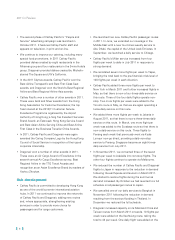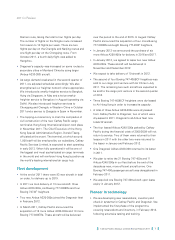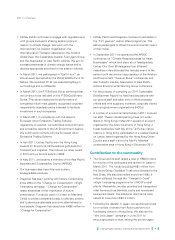Cathay Pacific 2011 Annual Report Download - page 5
Download and view the complete annual report
Please find page 5 of the 2011 Cathay Pacific annual report below. You can navigate through the pages in the report by either clicking on the pages listed below, or by using the keyword search tool below to find specific information within the annual report.
Cathay Pacific Airways Limited Annual Report 2011 3
Chairman’s Letter
The Cathay Pacific Group reported an attributable profit of HK$5,501 million for 2011.
This compares to the profit of HK$14,048 million for 2010, which was a record
year for the Group. The 2010 results included HK$3,033 million of significant
non-recurring items being the profit on the sales of our shareholdings in Hong Kong
Air Cargo Terminals Limited (“Hactl”) and Hong Kong Aircraft Engineering Company
Limited (“HAECO”) and the gain on the deemed disposal of part of our interest in
Air China. Adjusting for these items, the attributable profit in 2011 decreased by
HK$5,514 million or 50.1% from 2010. Earnings per share fell by 60.9% to HK139.8
cents. Turnover for the year increased by 9.9% to HK$98,406 million.
In 2011 the core business of the Cathay Pacific Group
was materially affected by instability and uncertainty in
the world’s major economies. The passenger business of
Cathay Pacific and Dragonair held up relatively well mainly
as a result of strong demand for premium class travel.
The cargo business was adversely affected by a
substantial reduction in demand for shipments from our
two key export markets, Hong Kong and Mainland China.
Fuel is our biggest single cost and the persistently high
jet fuel prices had a significant effect on our operating
results in 2011. Disregarding the effect of fuel hedging,
the Group’s gross fuel costs increased by HK$12,455
million (or 44.1%) in 2011. The increase reflected both
higher fuel prices and the fact that we operated more
flights. Managing the risk associated with changing fuel
prices remains a high priority. To this end we have an
active fuel hedging programme. In 2011 we realised a
profit of HK$1,813 million from fuel hedging activities,
with unrealised mark-to-market gains of HK$436 million in
the reserves at 31st December 2011.
Passenger revenue for the year was HK$67,778 million,
an increase of 14.2% compared with 2010. Capacity
increased by 9.2%. We carried a total of 27.6 million
passengers, a rise of 2.9% compared with 2010. The load
factor fell by 3.0 percentage points. Yield increased by
8.7% to HK66.5 cents. The relative strength of a number
of the currencies in which we receive revenues made a
positive contribution to our revenues. Demand for
premium class travel remained robust in 2011. Firm
demand for business class seats on short-haul routes
reflected the relative strength of the Asian economy.
Load factors in economy class remained generally high,
particularly on the North American and Southeast Asian
routes. However, there was a reduction in economy class
yield on long-haul routes. Business to and from Japan
was affected by the earthquake and subsequent tsunami
which took place in March 2011. Business to and from
Thailand was affected by the serious floods there in
October and November.
Cargo revenue for 2011 was up by 0.3% to HK$25,980
million compared with 2010. Cargo business performed
reasonably well in the first quarter of 2011. However,
from April onwards, demand for shipments from our two
most important markets, Hong Kong and Mainland China,
weakened significantly and remained weak for the rest of
the year. We managed capacity in order to keep it in line
with demand and continued to seek opportunities in new
markets. Yield was up by 3.9% to HK$2.42. Capacity
increased by 6.9%. The load factor, however, fell by 8.5
percentage points to 67.2%. In 2011 we started cargo
services to Bengaluru in India, Chongqing and Chengdu in
Western China and Zaragoza in Spain.
We continue to acquire new aircraft to replace older, less
efficient aircraft and to increase the size of the fleet. In
2011, we took delivery of six Boeing 777-300ERs, three
Airbus A330-300s and four Boeing 747-8F freighters. Two
new Airbus A320-200s joined the Dragonair fleet in
February 2012. In March 2011, we announced orders for
27 new aircraft, including two Airbus A350-900s (which
had been ordered in December 2010), 15 Airbus
A330-300s and 10 Boeing 777-300ERs. In August 2011,
we announced the acquisition of four more Boeing


















